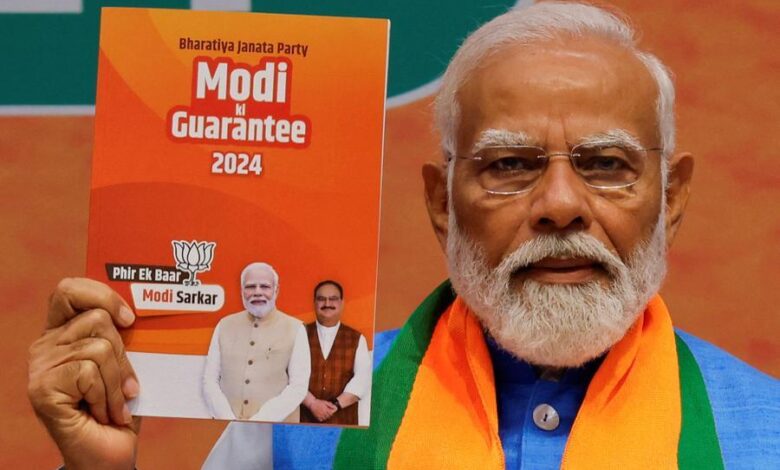Heading Into The World’s Biggest Poll, A Reality Check On How India Has Fared Under Modi And How Far Is The Goal Of Becoming An Economic Superpower?
As India gears up for the world's largest democratic exercise, the forthcoming election holds immense significance. Prime Minister Narendra Modi seeks another mandate, vowing to lead the nation through its flourishing economic transformation. With India set to emerge as a 21st-century economic powerhouse, investors, businesses, and policymakers around the globe are closely monitoring its trajectory. However, amidst the optimism surrounding Modi's leadership, questions persist about the true state of India's economy and the hurdles it must overcome to realize its full potential. What has been the economic progress under Modi's tenure, what are the key challenges, and what are the hurdles in India's path forward in its quest for powerhouse status?

As India embarks on the world’s largest democratic exercise, the stakes are high.
Prime Minister Narendra Modi seeks another five-year term, promising to lead the nation through its rapid economic expansion.
Investors, consumer brands, and manufacturers are eyeing it as a viable alternative to China, and economists worldwide are touting India to emerge as a 21st-century economic powerhouse.
However, given the optimism, questions remain about India’s economy’s actual state and challenges.
True Economic Data
Modi’s leadership has been characterized by ambitious economic reforms aimed at accelerating growth and attracting foreign investment.
India’s economy has indeed made significant strides under his tenure, but the road to prosperity is still long. One primary concern is the reliability of economic data, which often paints an incomplete picture of the country’s complex economic fundamentals.
While India’s GDP growth rates have been impressive, critics argue that they do not reflect the ground realities of a nation struggling with widespread poverty and income inequality.
Moreover, the COVID-19 pandemic exposed vulnerabilities in India’s healthcare infrastructure and highlighted the need for sustained investment in social welfare programs.
Nevertheless, there are undeniable signs of progress.
Modi’s initiatives such as “Make in India” and “Digital India” have attracted foreign companies eager to capitalize on India’s vast consumer market and skilled workforce.
The government’s emphasis on infrastructure development, including the ambitious Bharatmala and Sagarmala projects, aims to enhance connectivity and drive economic growth across the country.
India’s diplomatic efforts have also borne fruit, with improving relations with major economies offering new opportunities for trade and investment.
Unlike China, India enjoys relatively stable ties with the West, positioning it as an attractive destination for businesses seeking to diversify their supply chains.
However, significant challenges lie ahead on India’s path to economic powerhouse status.
One pressing issue is the need to address structural barriers to growth, including bureaucratic red tape, regulatory complexity, and inadequate infrastructure.
The country’s labour market reforms have been met with resistance from certain quarters, hindering efforts to create more formal employment opportunities.
Moreover, India faces persistent challenges in sectors such as agriculture, where outdated practices and inadequate infrastructure impede productivity and growth.

Rich Getting Richer, Poor, Alas!
Another critical concern is the widening wealth gap, which threatens social cohesion and economic stability. While India boasts a growing middle class, millions of people still live in poverty.
Additionally, environmental degradation and climate change pose significant risks to India’s long-term economic prospects. India has had the fortune of having 85 of the most polluted cities in the world in the list of 100. Imagine!
India’s GDP
India’s economic ascent under Modi’s leadership has made the South Asian giant the world’s fifth-largest economy.
Analysts project a sustained growth trajectory of at least 6% annually in the coming years, positioning India favorably on the global economic stage.
However, some argue that to truly ascend to economic superpower status, India must target growth rates of 8% or higher, a goal that necessitates bold reforms and strategic investments.
The Reality Check
Despite its impressive GDP figures, India struggles with the stark reality of income inequality and disparities in living standards.
While the economy booms, GDP per capita—a crucial measure of individual prosperity—lags behind, ranking a lowly 147 in 2022 according to the World Bank.
Guido Cozzi, a leading expert in macroeconomics, emphasises the importance of addressing income inequality alongside overall economic growth. While there are anticipated trickle-down effects as the economy expands, Cozzi cautions against relying solely on such mechanisms, advocating instead for policies that foster inclusive growth.

Infrastructure Transformation and Digital Innovation
India’s infrastructure overhaul is unmistakable, fueled by significant capital injections and private sector participation.
The federal budget earmarked a staggering $134 billion for capital spending in a single year, signaling the government’s commitment to catalyzing economic expansion.
The tangible results of this investment are evident in the flurry of construction activities across the nation, with the national highway network expanding by a remarkable 60% between 2014 and 2023.
In tandem with physical infrastructure development, India has embraced digital innovations that revolutionize governance and empower its citizens.
Initiatives like the Aadhaar program have provided millions with a unique proof of identity, curbing corruption and enhancing efficiency in welfare delivery.
Similarly, the Unified Payments Interface (UPI) has democratized financial transactions, enabling seamless digital payments for individuals and businesses alike.
Prime Minister Modi’s assertion, citing a World Bank report, spotlights the transformative impact of India’s digital public infrastructure in achieving financial inclusion targets in record time.

The Reality Check
Given the euphoria of infrastructure progress, India struggles with the sobering reality of quality assurance and maintenance.
While vast sums are allocated for construction and development projects, concerns persist regarding the durability and longevity of these ventures. Instances of bridge collapses and road failures following the onset of monsoons are the true barometer.
The crux of the issue lies in the governance framework governing tendering processes and project execution.
Despite stringent regulations and oversight mechanisms, corruption and influence peddling are large, compromising the integrity of infrastructure projects.
The nexus between money, power, and influence often undermines efforts to uphold standards and ensure accountability, resulting in a cycle of substandard construction and wasted resources.

The High On Stock Market
India’s economic resurgence is vividly reflected in its soaring stock market, which has scaled unprecedented heights in recent years; the combined value of companies listed on Indian exchanges surpassing $4 trillion, the nation’s stock market has emerged as a global powerhouse.
Likewise, the Modi government’s push to revitalize the manufacturing sector has gained significant attention, attracting multinational corporations seeking to diversify their supply chains away from China.
India’s stock market has experienced a meteoric rise, propelled by both domestic and foreign investors.
The National Stock Exchange of India (NSE) has catapulted to the sixth position globally, overtaking prominent exchanges like the Shenzhen Stock Exchange and the Hong Kong Exchange.
Retail investors, buoyed by the optimism surrounding India’s growth prospects, have flocked to the market, while institutional investors have also played a significant role in driving valuations to record highs.
Despite concerns about inflated IPO valuations and speculative trading, the enthusiasm surrounding India’s stock market shows no signs of abating.

The Reality Check, Hype and Substance
Behind the facade of record-breaking stock market rallies lies a nuanced reality characterized by volatility and speculation.
The surge in IPOs, particularly from startups, has raised eyebrows, with concerns about inflated valuations and dubious profitability overshadowing genuine investment opportunities.
The Modi government’s efforts to attract foreign investment through policy incentives and manufacturing incentives have yielded mixed results, with questions raised about the long-term sustainability of such initiatives.
Moreover, the reliance on foreign capital inflows to drive stock market growth raises concerns about vulnerability to external shocks and the potential for capital flight in times of uncertainty.

The Drive for Manufacturing Excellence
In parallel with the stock market fervor, India is witnessing a resurgence in manufacturing driven by the government’s aggressive incentives and international companies’ desire to diversify supply chains.
The production-linked incentive program, worth $26 billion, has incentivized investment in sectors ranging from electronics to pharmaceuticals, positioning India as an attractive destination for manufacturing expansion.
Notable firms like Foxconn and Tesla have announced plans to ramp up operations in India, signaling confidence in the country’s manufacturing capabilities.
The Reality Check, Impact on Exports and Economic Growth
While the surge in manufacturing activity is promising, questions arise about the extent to which it translates into tangible benefits for India’s economy.
Despite the expansion of manufacturing facilities, the contribution of these products to India’s export market remains a subject of scrutiny.
Moreover, concerns persist about the quality and competitiveness of Indian-manufactured goods vis-à-vis global standards.

The Real Question – Where Are The Jobs?
While India’s economic and democratic strides garner global attention, job creation is a pressing challenge.
With a youthful population characterized by an average age of 29 years, India possesses immense human capital potential; however, harnessing this demographic dividend requires concerted efforts to address the mismatch between aspirations and available opportunities.
Despite advancements in education and skill development, unemployment looms large, particularly among the educated youth.
A report by the International Labour Organization spotlights the paradox of educated Indian youth facing higher unemployment rates than their less-educated counterparts.
The grim reality of unemployment in India is reflected in stark statistics, with youth unemployment rates surpassing global levels.
Despite educational attainment, young Indians face formidable challenges in securing meaningful employment, leading to frustration and disillusionment.
The Last Bit, India has definitely gained a lot of positive attention in the global arena in recent years, but how much of it has translated to actual wealth in the hands of the citizens?
Safety and security remain primary concerns, as does the dwindling of valuable resources (e.g., the water crises in Bengaluru), largely due to appeasing politics and corruption.
Inflation and a lack of employment opportunities are vicious circles, and the government has not addressed this critical issue!
Therefore, how much growth has India actually achieved under Modi’s leadership – is for each one to ask and answer!






